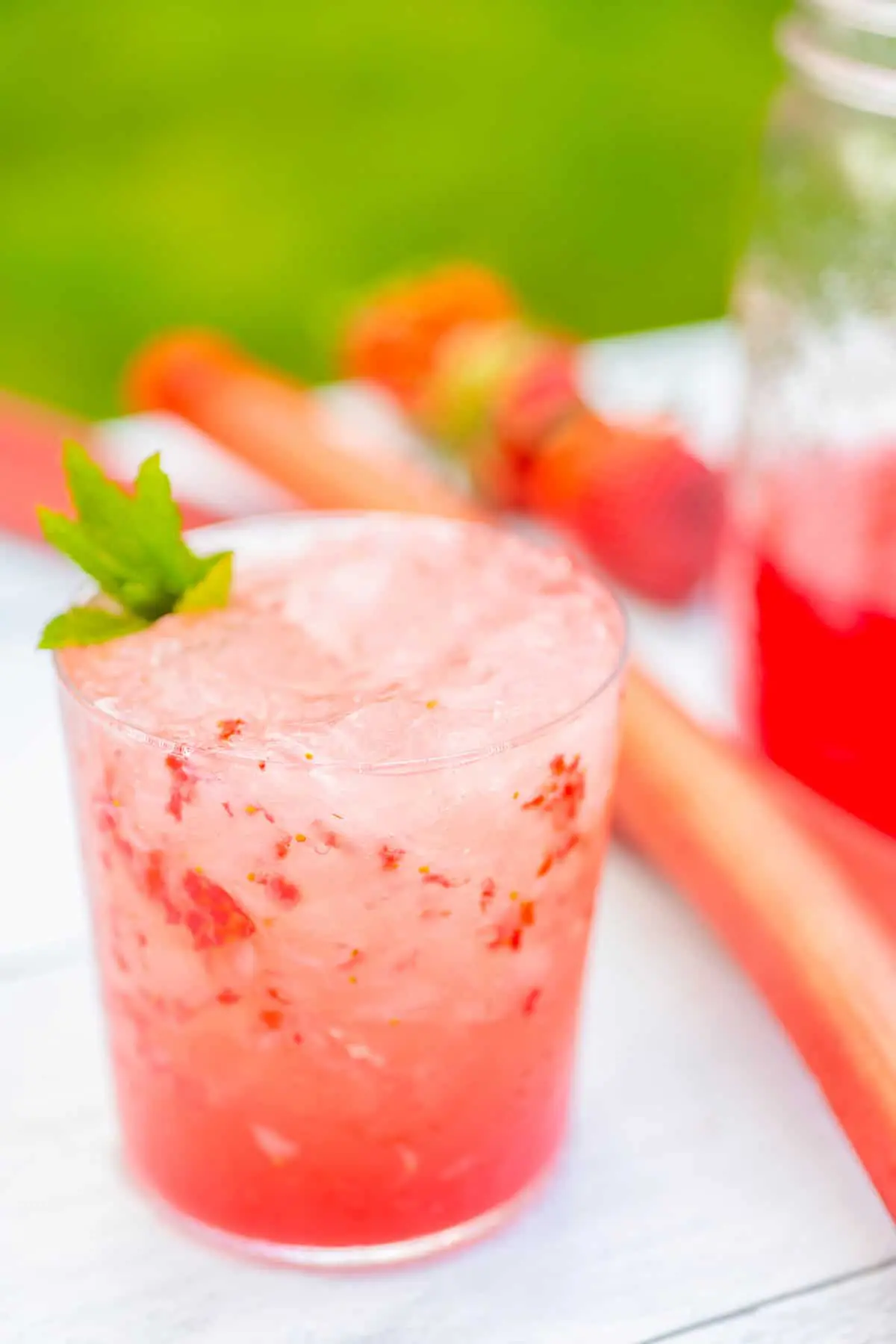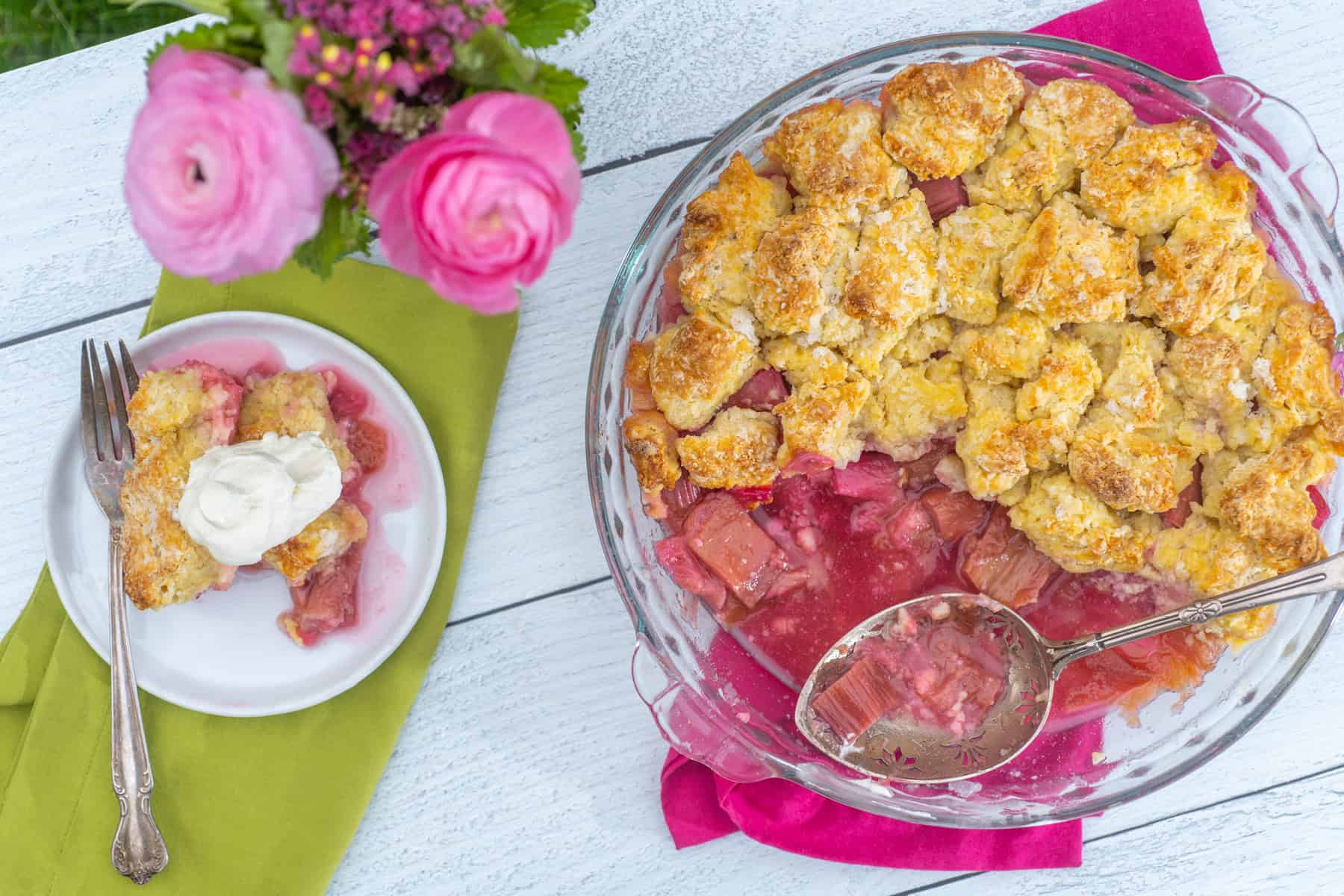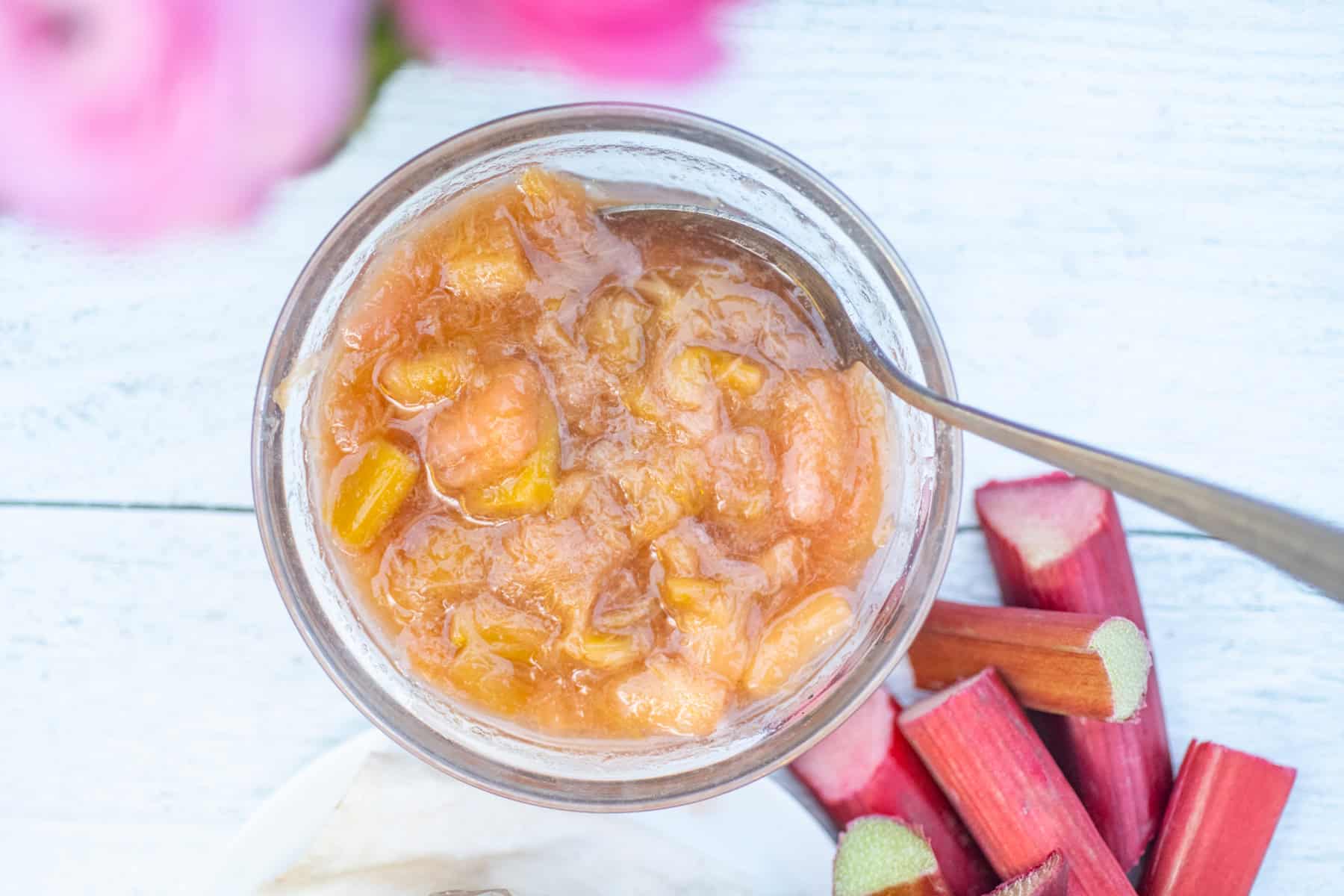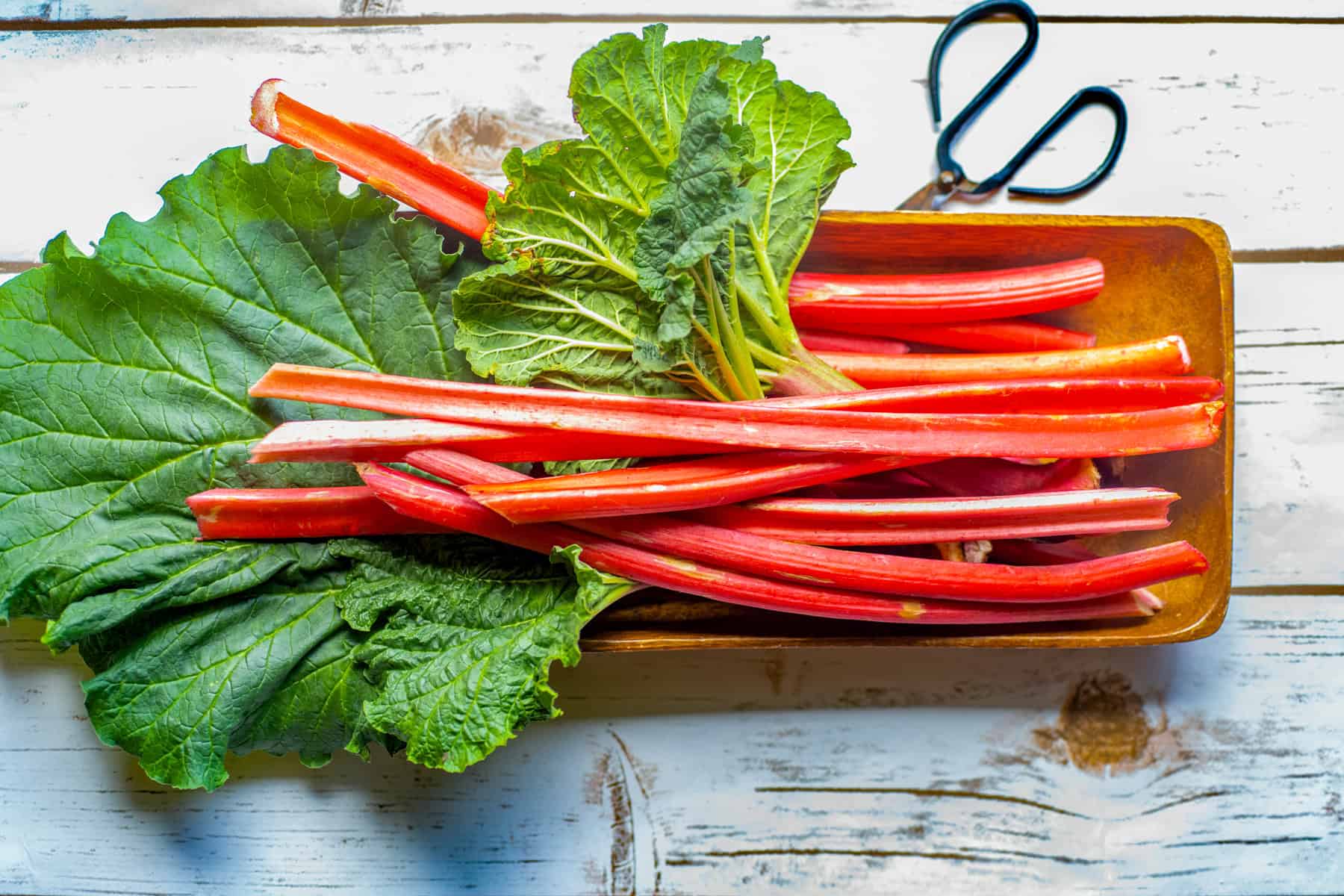By Kate Hull // Photography by Paulette Phlipot
—
Rhubarb, a vegetable (yes, it’s a vegetable typically used like fruit), is steeped in nostalgia for me. The colorful, hearty stalks are a staple in my kitchen each spring. Most often, I harvest them from the abundant plant in my yard that returns year after year, a harbinger of the summer season ahead. But sometimes, I grab extra bundles at the farmers market just to prove that rhubarb is so much more than its “pie plant” reputation.
So, why do I fuss about rhubarb?
Our Teton summers provide a bounty of incredible produce with abundant gardens and greenhouses stocked with hearty root vegetables, beautiful blooms, and even a variety of ripe tomatoes and peppers. But I confess, I am no gardener. I will be the first in line at the farmers market to support our local growers and cheer them on in their endeavors. Still, you will find nothing but failed garden beds at my abode, sans the robust stocks of rhubarb sprouting nearby, a welcomed consolation prize.
When my husband, Kenny, and I were married in 2016, we were gifted a rhubarb plant, said to be a good omen for a happy union. We have transferred it three times since — once to our new home and two additional times to find its perfect spot on our acreage. Now, eight years later, it thrives, yielding multiple harvests year after year for my favorite savory and sweet kitchen endeavors.
And you know how a recipe can beckon memories or a smell can take you back in time? Using this vibrant veggie sends me back to cherished moments with my late, dear Aunt Randy, who enjoyed rhubarb as the star ingredient in a pie, just like her dad, my grandpa, once did. Come Christmas, it’s now a staple on our dessert table and a reminder of Aunt Randy’s big laugh and infectious personality. Sweet and bold, like rhubarb.
And while it may seem like a one-hit-wonder, rhubarb has been used for its medicinal qualities for centuries.
Tradition, legend, and lore
Native to Siberia, rhubarb is a perennial herb whose stalks, which can vary in hue from a deep red to a vibrant green, can grow to nearly 3 feet tall. This hardy plant thrives in cold climates with direct sunlight — making Teton Valley prime habitat to nurture a rhubarb garden.
According to the White Rabbit Institute for Healing, rhubarb was one of the first Chinese medicines to be imported to the West. Early documents first associated rhubarb with its ability to aid in digestion by alleviating constipation. It is also rich in vitamin K and fiber, linking the colorful stalks to bone health. Its medicinal properties run the gamut from relieving inflammation and menstruation symptoms to aiding in gut health.
While the stalks have a variety of uses, the leaves are toxic, thanks to the oxalic acid found in them. Some people worry the toxins can seep into the stalks, so it’s best to immediately remove the leaves after harvest
This lush plant has also cropped up in folklore as a symbol of renewal, prosperity, and resilience. It’s no wonder. After the spring thaw — during those particularly rough mud-season months when we start to wonder if spring will ever appear — rhubarb is one of the first to break through the ground, reassuring us that it will come.
How does your garden grow?
Rhubarb is a one-crop gardener’s dream. Once established, it requires very little — and I mean little to no — maintenance yet produces bountiful yields. How little maintenance? Well, after I transplanted my beloved plant to its new home in our backyard, my husband accidentally mowed it down, not once but twice, in the early days of using his new riding lawnmower. But low and behold, that good omen of a happy union returned that season and our marriage continued to thrive right alongside our healthy plant.
Rhubarb grows best in full sun planted in lightly moist soil. The plant is frost tolerant, so any late June freeze won’t send it cowering. In fact, cold temperatures during its dormant months are key for a prosperous spring and summer growing season.
Rhubarb is susceptible to root rot, so it needs to find a home in soil with good drainage. (Adding compost to your soil can improve its overall drainage abilities.)
It’s also the perfect community-minded garden staple. Rhubarb is meant to be cultivated and shared, again and again. To share your plant, it is best to dig it up either in the spring or the fall when it’s dormant. Dig up the entire root system of the plant. Then, divide the root ball into however many sections you need, ensuring that each section has at least one healthy bud with roots. Then, replant your rhubarb and share with those you love!
I love knowing my rhubarb plants have come from a variety of places: the first as a wedding gift, another from a friend’s backyard, and one split amongst friends from a mother plant nearly a decade old. Just like the pie you whip up for that potluck, or the mocktail you serve at your backyard party, sharing the bounty is built into the very essence of rhubarb.

Rhubarb Mocktail
—
The perfect refreshing mocktail for a hot summer day. I opt for a sugar-based syrup because of rhubarb’s tart flavor profile, but the sugar in this recipe can also be subbed with honey.
—
For the Simple Syrup:
3 cups chopped rhubarb
1 cup sugar
1 cup water
Squeeze of lemon juice
Chopped ginger or basil (optional)
For the Mocktail:
2 to 3 tablespoons simple syrup
2 large or 4 small muddled strawberries (optional)
6 to 8 ounces sparkling water of choice (I love Topo Chico)
ice cubes
1 sprig fresh mint
- Combine the rhubarb, sugar, water, and lemon juice in a saucepan. If you’re including ginger or basil, add it now.
- Stir and bring to a boil.
- Reduce heat to low and simmer until the rhubarb breaks down, around 15 or 20 minutes.
- Remove from heat and let cool.
- Strain the mixture through a fine mesh sieve into a wide-mouth Mason jar. The color should be a beautiful pink.
- Pour approximately 3 tablespoons of the syrup into a short cocktail glass. Muddle the strawberries into the syrup (if using). Add ice cubes, fresh mint, and top with sparkling water and stir.
Best enjoyed on the porch. :)
* Simple syrup can be stored in the fridge in a Mason jar for up to two weeks; recipe can be cut in half.

Not-Your-Typical Rhubarb Cobbler
—
I know, I know. Rhubarb’s other name is “the pie plant.” And most home chefs use strawberries in their pie. I, however, am a purest. So, here is my go-to cobbler recipe; the almond flavor blends perfectly with the tartness of the rhubarb.
—
For the filling:
4 cups chopped rhubarb
1 cup sugar
1/4 teaspoon salt
2 tablespoons lemon juice
1 teaspoon almond extract
For the crumb:
2 cups all-purpose flour
2 tablespoons sugar
1/4 teaspoon salt
1 tablespoon baking powder
1/2 cup chilled butter, cut into ½-inch pieces
1/2 cup whole milk
1 large egg
Preheat oven to 400 F.
- For the filling, combine rhubarb, sugar, salt, lemon juice, and almond extract in a bowl. Stir and set aside.
- In a second bowl, combine flour, sugar, salt, and baking powder. Stir together. Incorporate butter with a pastry cutter or your fingers until dispersed and crumbly.
- Beat the egg and milk together in a third bowl. Pour it into the flour mixture and stir with a fork until evenly moistened.
- Pour the rhubarb filling into a buttered 9-inch baking dish.
- Drop spoonfuls of dough on top of the rhubarb. You don’t have to cover every nook and cranny but use up all the dough. (This isn’t your typical crumble-type cobbler recipe. Think biscuit consistency, here.) Sprinkle additional sugar over the top, if desired.
- Bake for 30 to 35 minutes or until golden brown and bubbly.
- Serve with homemade whipped cream or vanilla ice cream.
(If you’d like to try this in pie form, simply pour the rhubarb filling into your favorite pie crust, top with a gorgeous lattice design, and bake.)
* Recipe adapted from thepioneerwoman.com.

Simple Rhubarb Sauce
—
This sauce is inspired by the team at Pizzeria Alpino in Driggs.
Last summer, Becky Koenig whipped up a rhubarb sauce to adorn her husband, and chef, John Koenig’s cheesecake.
—
2 large or 3 medium stalks of rhubarb
1/4 cup water
1 teaspoon lemon zest
3 tablespoons sugar or honey
- Cut the dried ends of your rhubarb, but do not cut all the way through the stalk. Grab the soon-to-be-discarded end and pull upwards, thus peeling off most of the stalky, rigid part. Repeat on the other end.
- Chop the rhubarb into half-inch pieces to yield 1½ cups.
- Place the chopped rhubarb, water, lemon zest, and honey or sugar in a saucepan.
- Cook on low to medium-low heat, stirring occasionally, until the rhubarb breaks down into a lumpy sauce-like texture (approximately 20 minutes).
- Leave as is! Or, for a smoother consistency, blend with an immersion blender.
- Store in a Mason jar in the refrigerator and serve over desserts, savory meats, or whatever your heart desires.
* Recipe adapted from masalaherb.com.

